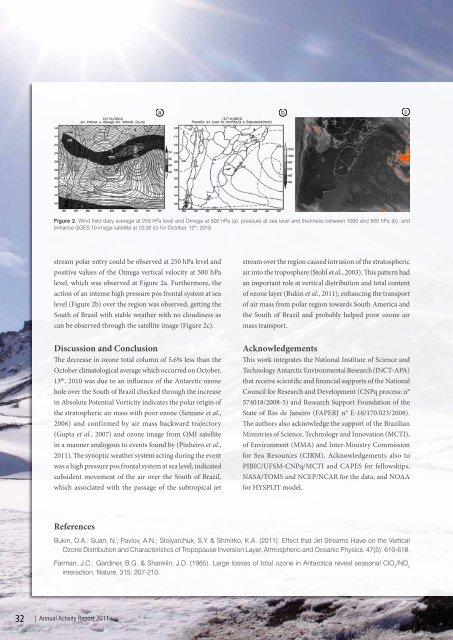1 - Instituto de Biologia da UFRJ
1 - Instituto de Biologia da UFRJ
1 - Instituto de Biologia da UFRJ
Create successful ePaper yourself
Turn your PDF publications into a flip-book with our unique Google optimized e-Paper software.
a b c<br />
Figure 2. Wind field <strong>da</strong>ily average at 250 hPa level and Omega at 500 hPa (a), pressure at sea level and thickness between 1000 and 500 hPa (b), and<br />
enhance GOES 10 image satellite at 12:00 (c) for October, 12 th , 2010.<br />
stream polar entry could be observed at 250 hPa level and<br />
positive values of the Omega vertical velocity at 500 hPa<br />
level, which was observed at Figure 2a. Furthermore, the<br />
action of an intense high pressure pos frontal system at sea<br />
level (Figure 2b) over the region was observed, getting the<br />
South of Brazil with stable weather with no cloudiness as<br />
can be observed through the satellite image (Figure 2c).<br />
stream over the region caused intrusion of the stratospheric<br />
air into the troposphere (Stohl et al., 2003). This pattern had<br />
an important role at vertical distribution and total content<br />
of ozone layer (Bukin et al., 2011), enhancing the transport<br />
of air mass from polar region towards South America and<br />
the South of Brazil and probably helped poor ozone air<br />
mass transport.<br />
Discussion and Conclusion<br />
The <strong>de</strong>crease in ozone total column of 5.6% less than the<br />
October climatological average which occurred on October,<br />
13 th , 2010 was due to an influence of the Antarctic ozone<br />
hole over the South of Brazil checked through the increase<br />
in Absolute Potential Vorticity indicates the polar origin of<br />
the stratospheric air mass with poor ozone (Semane et al.,<br />
2006) and confirmed by air mass backward trajectory<br />
(Gupta et al., 2007) and ozone image from OMI satellite<br />
in a manner analogous to events found by (Pinheiro et al.,<br />
2011). The synoptic weather system acting during the event<br />
was a high pressure pos frontal system at sea level, indicated<br />
subsi<strong>de</strong>nt movement of the air over the South of Brazil,<br />
which associated with the passage of the subtropical jet<br />
Acknowledgements<br />
This work integrates the National Institute of Science and<br />
Technology Antarctic Environmental Research (INCT-APA)<br />
that receive scientific and financial supports of the National<br />
Council for Research and Development (CNPq process: n°<br />
574018/2008-5) and Research Support Foun<strong>da</strong>tion of the<br />
State of Rio <strong>de</strong> Janeiro (FAPERJ n° E-16/170.023/2008).<br />
The authors also acknowledge the support of the Brazilian<br />
Ministries of Science, Technology and Innovation (MCTI),<br />
of Environment (MMA) and Inter-Ministry Commission<br />
for Sea Resources (CIRM). Acknowledgements also to<br />
PIBIC/UFSM-CNPq/MCTI and CAPES for fellowships,<br />
NASA/TOMS and NCEP/NCAR for the <strong>da</strong>ta, and NOAA<br />
for HYSPLIT mo<strong>de</strong>l.<br />
References<br />
Bukin, O.A.; Suan, N.; Pavlov, A.N.; Stolyarchuk, S.Y. & Shmirko, K.A. (2011). Effect that Jet Streams Have on the Vertical<br />
Ozone Distribution and Characteristics of Tropopause Inversion Layer. Atmospheric and Oceanic Physics. 47(5): 610-618.<br />
Farman, J.C.; Gardiner, B.G. & Shanklin, J.D. (1985). Large losses of total ozone in Antarctica reveal seasonal ClO x<br />
/NO x<br />
interaction. Nature, 315: 207-210.<br />
32 | Annual Activity Report 2011

















